Because of the number of relatively large images, this
article has been split over two pages. Safari, Opera, and iCab are
covered page 1, and Firefox 3 Beta 5 is covered here.
Firefox 3 'Gran Paradiso' Beta 5
Then there's Mozilla's Firefox 3 "Gran Paradiso" browser, which has
reached Beta 5 status, probably the last beta before the version 3
final is released. Notwithstanding Mozilla's disclaimers that the
version 3 betas are for "testing" and developer evaluation only, I
haven't encountered any reason with any of the version 3 Firefox betas
not to use them for regular, workaday browsing. I've not traditionally
been much of a Firefox fan, but Beta 5 is the slickest, most polished
Firefox browser ever, not to mention the fastest and prettiest. IMHO
it's a lot better vehicle with which to cruise the Information
Superhighway than the latest version of Firefox 2 is.
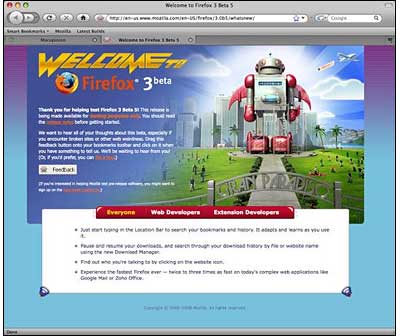
Last Wednesday, Mozilla.org released Firefox 3 beta 5, and Firefox's
incremental updates continue to be the most elegant and user-friendly
in the business, downloading unobtrusively in the background, then
displaying a polite dialog asking if you want to install the updated
files. If you give the go-ahead, it only take a minute or two, the
program restarts, and it then proceeds to restore whatever pages or
tabs you had open - very user-friendly and convenient.
Incidentally, Firefox 3 does a masterful job of restoring your web
sessions even after routine close/startups. The program (again
politely) asks you if you want to save the current session when you
shut it down.
According to Mozilla.org, Firefox 3 Beta 5 includes more than 750
changes from the previous beta, which in turn contained over 900
improvements over the version before that, enhancing stability and
compatibility, providing a fresh look and platform and user interface
enhancements, and resulting in the fastest Firefox ever. Many of these
improvements were based on community feedback from the previous beta.
However, I didn't notice as much of a speed improvement, compared with
previous version 3 beta releases, and the interface appearance seems to
have been pretty much finalized with the Beta 4 release.
Firefox 3 is based on the Gecko 1.9 rendering platform, which has
been under development for the past 31 months. Building on the previous
release, Gecko 1.9 has more than 12,000 updates, including some major
re-architecting to provide improved performance, stability, rendering
correctness, and code simplification and sustainability. Firefox 3 has
been built on top of this new platform, resulting in a more secure,
easier to use, more personal product with a lot more under the hood to
offer website and Firefox add-on developers.
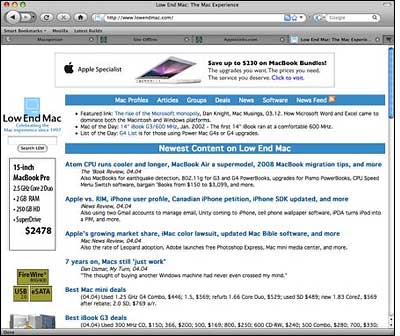
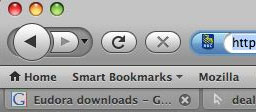 Since the
Firefox 3 beta 3 release, Firefox for Mac has a much-improved and more
attractive user interface with a more native Mac OS X look,
smaller buttons, and more compact tabs. In beta 4, the Mac version of
the browser got the new forward/back buttons (which debuted in the
Windows version of beta 3). With the demise of Netscape Navigator 9,
this new Firefox is to my mind the best-looking Gecko-based
browser.
Since the
Firefox 3 beta 3 release, Firefox for Mac has a much-improved and more
attractive user interface with a more native Mac OS X look,
smaller buttons, and more compact tabs. In beta 4, the Mac version of
the browser got the new forward/back buttons (which debuted in the
Windows version of beta 3). With the demise of Netscape Navigator 9,
this new Firefox is to my mind the best-looking Gecko-based
browser.
Also new
in beta 4 was one-click site info: Just click the site favicon in the
location bar, and an information dialog appears.
If that doesn't provide enough info, click the More Information
button, and a window appears with 4 tabs containing a whole raft of
data pertaining to the page you're on, allowing you to check if your
connection is protected from eavesdropping. Identity verification is
prominently displayed and easier to understand.
When a site uses Extended Validation (EV) SSL certificates, the site
favicon button will turn green and show the name of the company you're
connected to.
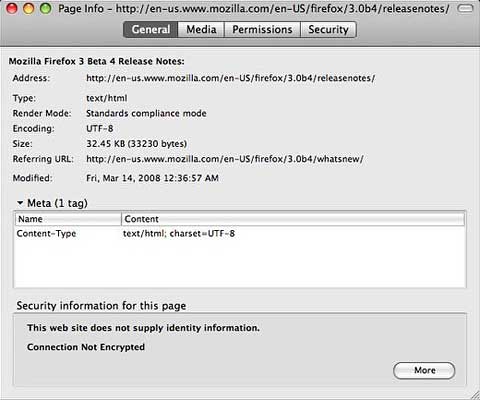
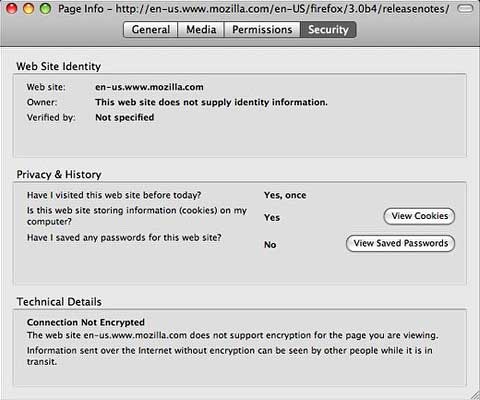
Firefox 3's location bar autocomplete now looks on visited and
bookmarked page titles and tags as well as web addresses, and it
highlights which parts of the page title and/or URL match the entered
text. Results for autocomplete are shown in two lines: one for page
title and the other for web address - and in contrasting colors making
it easier to isolate one or the other depending on what you're looking
for. Also, matched terms are highlighted to direct attention.
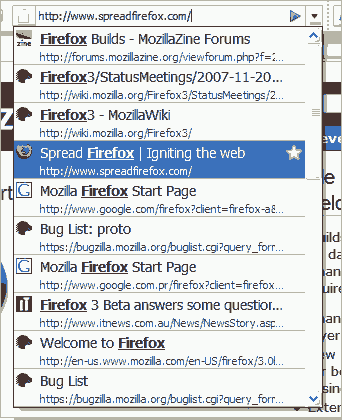
Beta 5's Smart Location feature incorporates an improved search
algorithm that "calculates the recency and frequency" of sites visited
to help yield search results of highest relevancy. You can also
associate keywords with bookmarks to sort them by topic.
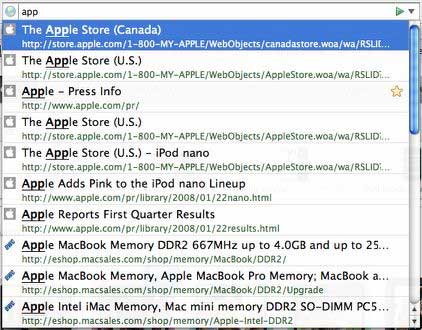
The downloads manager has also been improved (although I still think
Opera has the best downloads manager in the business), with support for
searching through previous downloads, resuming downloads between
sessions, and it now displays the domain of the source site next to
each completed download.
The Places feature, which organizes bookmarks and browser history,
has also been enhanced, offering improved search functionality, and a
new Smart Bookmarks folder on the Bookmarks Toolbar.
It's now possible to search History, tags, and bookmarks with a
real, configurable search interface, and the Mac OS X version of
Firefox 3 now has full support for native widgets in forms.
Probably my favorite new feature in Firefox 3 is that before
shutting down, Firefox puts up a dialog asking if you want to save the
contents of tabs in your current browsing session. In most instances I
definitely do, and the icing on the proverbial cake is that the tabs
get reloaded from the cache, which no longer gets dumped on shutdown if
you choose the save option with satisfying dispatch upon starting the
program again. This is a big enhancement from Firefox 2's ability to
remember the contents of tabs after program crashes.
Firefox 3 features:
- Redesigned download manager
- Redesigned add-ons manager
- Download pause and resume
- Visual refresh
- Places
- Redesigned location bar
- Full page zoom
- Offline web apps support
- Security improvements
- Better OS integration
- Web content and protocol handling
- Discontinuous selections
Some new features and fixes in Beta 5:
- Just start typing in the Location Bar to search your bookmarks and
history. It adapts and learns as you use it.
- Pause and resume your downloads, and search through your download
history by file or website name using the new Download Manager.
- Find out who you're talking to by clicking on the website
icon.
- Experience the fastest Firefox ever - twice to three times as fast
on today's complex web applications like Google Mail or Zoho
Office.
- Places Organizer: view, organize and search through all of your
bookmarks, tags, and browsing history with multiple views and smart
folders to store your frequent searches. Create and restore full
backups whenever you want.
- [Improved in Beta 5!] Integration with Windows: Firefox now has
improved Windows icons, and uses native user interface widgets in the
browser and in web forms.
- [Improved in Beta 5!] Integration with the Mac: the new Firefox
theme makes toolbars, icons, and other user interface elements look
like a native OS X application. Firefox also uses OS X widgets and
supports Growl for notifications of completed downloads and available
updates. A combined back and forward control make it even easier to
move between web pages.
- [Improved in Beta 5!] Integration with Linux: Firefox's default
icons, buttons, and menu styles now use the native GTK theme.
One minor caveat is that switching to Firefox 3 may break some
plugins you're using with Firefox 2, although that issue is improving
as plugin developers step up and release Firefox 3 compatible
versions.
Firefox 3.0's memory demands were "dramatically improved" with Beta
4, and it does seem like a better citizen on my Desktop than earlier
versions.
They're also not kidding about the speed. This is a blazing fast
browser.
No release date has been announced for the Firefox 3 final, but in
the meantime, beta 5 is a completely acceptable ride, and I would not
think of going back to Firefox 2.
Here are some more Firefox 3 improvements:
More Secure
- One-click site info: Click the site favicon in the location bar to
see who owns the site and to check if your connection is protected from
eavesdropping. Identity verification is prominently displayed and
easier to understand. When a site uses Extended Validation (EV) SSL
certificates, the site favicon button will turn green and show the name
of the company you're connected to.
- Malware Protection: malware protection warns users when they arrive
at sites which are known to install viruses, spyware, Trojans or other
malware.
- New Web Forgery Protection page: the content of pages suspected as
web forgeries is no longer shown.
- New SSL error pages: clearer and stricter error pages are used when
Firefox encounters an invalid SSL certificate.
- Add-ons and Plugin version check: Firefox now automatically checks
add-on and plugin versions and will disable older, insecure
versions.
- Secure add-on updates: to improve add-on update security, add-ons
that provide updates in an insecure manner will be disabled.
- Antivirus integration: Firefox will inform antivirus software when
downloading executables.
- Vista Parental Controls: Firefox now respects the Vista systemwide
parental control setting for disabling file downloads.
- Effective top-level domain (eTLD) service better restricts cookies
and other restricted content to a single domain.
- Better protection against cross-site JSON data leaks.
Easier to Use
- Easier password management: an information bar replaces the old
password dialog so you can now save passwords after a successful
login.<p>
- Simplified add-on installation: the add-ons whitelist has been
removed making it possible to install extensions from third-party sites
in fewer clicks.
- New Download Manager: the revised download manager makes it much
easier to locate downloaded files, and you can see and search on the
name of the website where a file came from. Your active downloads and
time remaining are always shown in the status bar as your files
download.
- Resumable downloading: users can now resume downloads after
restarting the browser or resetting your network connection.
- [Improved in Beta 4!] Full page zoom: from the View menu and via
keyboard shortcuts, the new zooming feature lets you zoom in and out of
entire pages, scaling the layout, text and images, or optionally only
the text size. Your settings will be remembered whenever you return to
the site.
- Podcasts and Videocasts can be associated with your media playback
tools.
- Tab scrolling and quickmenu: tabs are easier to locate with the new
tab scrolling and tab quickmenu.
- Save what you were doing: Firefox will prompt users to save tabs on
exit.
- Optimized Open in Tabs behavior: opening a folder of bookmarks in
tabs now appends the new tabs rather than overwriting.
- Location and Search bar size can now be customized with a simple
resizer item.
- Text selection improvements: multiple text selections can be made
with Ctrl/Cmd; double-click drag selects in "word-by-word" mode;
triple-clicking selects a paragraph.
- Find toolbar: the Find toolbar now opens with the current
selection.
- Plugin management: users can disable individual plugins in the
Add-on Manager.
- Integration with Vista: Firefox now has Vista-specific icons, and
uses native user interface widgets in the browser and in web
forms.
- Integration with the Mac: the new Firefox theme makes toolbars,
icons, and other user interface elements look like a native OS X
application. Firefox also uses OS X widgets and spellchecker in web
forms and supports Growl for notifications of completed downloads and
available updates. A combined back and forward control make it even
easier to move between web pages.
- Integration with Linux: Firefox's default icons, buttons, and menu
styles now use the native GTK theme.
More Personal
- Star button: quickly add bookmarks from the location bar with a
single click; a second click lets you file and tag them.
- Tags: associate keywords with your bookmarks to sort them by
topic.
- Location bar & autocomplete: type in all or part of the title,
tag or address of a page to see a list of matches from your history and
bookmarks; a new display makes it easier to scan through the matching
results and find that page you're looking for. Results are returned
according to their frequency (a combination of frequency and recency of
visits to that page) ensuring that you're seeing the most relevant
matches. An adaptive learning algorithm further tunes the results to
your patterns.
- Smart Bookmarks Folder: quickly access your recently bookmarked and
tagged pages, as well as your more frequently visited pages with the
new smart bookmarks folder on your bookmark toolbar.
- Places Organizer: view, organize and search through all of your
bookmarks, tags, and browsing history with multiple views and smart
folders to store your frequent searches.
- Web-based protocol handlers: web applications, such as your
favorite webmail provider, can now be used instead of desktop
applications for handling mailto: links from other sites. Similar
support is available for other protocols (Web applications will have to
first enable this by registering as handlers with Firefox).
- Download & Install Add-ons: the Add-ons Manager (Tools >
Add-ons) can now be used to download and install a Firefox
customization from the thousands of Add-ons available from our
community add-ons website. When you first open the Add-ons Manager, a
list of recommended Add-ons is shown.
- Easy to use Download Actions: a new Applications preferences pane
provides a better UI for configuring handlers for various file types
and protocol schemes.
- Improved Platform for Developers
- New graphics and font handling: new graphics and text rendering
architectures in Gecko 1.9 provides rendering improvements in CSS, SVG
as well as improved display of fonts with ligatures and complex
scripts.
- Color management: (set gfx.color_management.enabled on in
about:config and restart the browser to enable.) Firefox can now adjust
images with embedded color profiles.
- Offline support: enables web applications to provide offline
functionality (website authors must add support for offline browsing to
their site for this feature to be available to users).
- A more complete overview of Firefox 3 for developers is available
for website and add-on developers.
Improved Performance
- Speed: improvements to our JavaScript engine as well as profile
guided optimizations have resulted in significant improvements in
improvements over previous releases. Compared to Firefox 2, web
applications like Google Mail and Zoho Office run twice as fast in
Firefox 3 Beta 4, and the popular SunSpider test from Apple shows
increased performance
- Memory usage: Several new technologies work together to reduce the
amount of memory used by Firefox 3 Beta over a web browsing session.
Memory cycles are broken and collected by an automated cycle collector,
a new memory allocator reduces fragmentation, hundreds of leaks have
been fixed, and caching strategies have been tuned.
- Reliability: A user's bookmarks, history, cookies, and preferences
are now stored in a transactionally secure database format which will
prevent data loss even if their system crashes.
System requirements: Mac OS X 10.4 and later
Minimum Hardware
- Macintosh computer with an Intel x86 or PowerPC G3, G4, or G5
processor
- 128 MB RAM (Recommended: 256 MB RAM or greater)
- 200 MB hard drive space
Go to Page 1 for coverage of
Safari 3.1, Opera 9.27, and iCab 4.01.
Go to the Miscellaneous Ramblings Review index.



 Since the
Firefox 3 beta 3 release, Firefox for Mac has a much-improved and more
attractive user interface with a more native Mac OS X look,
smaller buttons, and more compact tabs. In beta 4, the Mac version of
the browser got the new forward/back buttons (which debuted in the
Windows version of beta 3). With the demise of Netscape Navigator 9,
this new Firefox is to my mind the best-looking Gecko-based
browser.
Since the
Firefox 3 beta 3 release, Firefox for Mac has a much-improved and more
attractive user interface with a more native Mac OS X look,
smaller buttons, and more compact tabs. In beta 4, the Mac version of
the browser got the new forward/back buttons (which debuted in the
Windows version of beta 3). With the demise of Netscape Navigator 9,
this new Firefox is to my mind the best-looking Gecko-based
browser.




